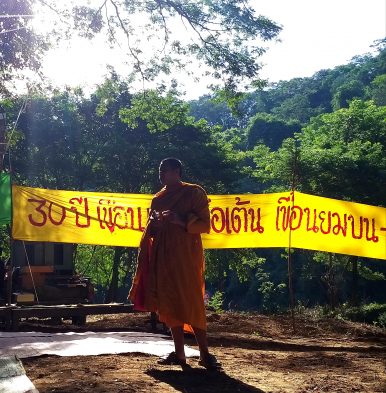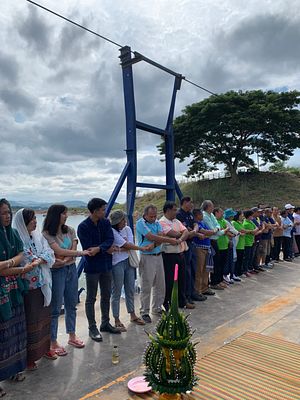For more than two decades, communities in Southeast Asia have been facing threats from the expansion of hydropower development. Dams have been justified by the governments of Southeast Asian countries as the main development agenda, which would generate large amounts of income and contribute to poverty alleviation. For example, Thailand’s expansion of energy consumption by investing in neighboring countries such as Laos and Myanmar is a trend designed to increase energy imports to sustain Thailand’s energy security. While Laos is being used as the “Battery of Asia,” hydropower dominates their national development agenda and selling electricity to the neighboring countries is the prime discussion among policymakers. Myanmar is catching up with trends, with coal mines and dams both listed in national development agendas.
While the dam agenda as a national development project is being promoted by decision makers and businesses across Southeast Asia, civil society organizations (CSOs) and communities advocate for a counternarrative demanding greater responsibility of the investors. They hope for accountability and respect for human rights alongside dam development.
The Kaeng Sue Ten and Anti-Dam Movements in Thailand
The coalition and network of anti-dam movements across Thailand and ASEAN have been on the rise. In Thailand, the community movement against Kaeng Sue Ten dam in the north is widely known. It is hailed as a “successful anti-dam model,” whereby thousands of communities have delayed dam construction on the Yom River in Kaeng Sue Ten for more than 30 years. It is the most delayed dam in Southeast Asia. It could be said that the framing of Kaeng Sue Ten dam as a project that threatens the only golden teak forest reserve in Thailand largely explains the movements’ success. Communities express strong solidarity and continue to protect their sacred forest.
Communities celebrated the 30th anniversary of their fight against Kaeng Sue Ten on November 2. The celebration included the organizing of a tree ordinance, a River Prayers ceremony to pay respect to the guardian spirits and ask for protection, and a community forum to share strategies across networks and alliances. Kamnan Chum, one of the charismatic leaders of the anti-Kaeng Sue Ten Dam movement expressed that “our fight against Kaeng Sue Ten dam has demonstrated our strong solidarity and unified stance among our communities who would like to pass on our treasures of land and resources to the next generation.”
“Our home is nothing without trees, lands and river resources… this is our heritage,” Kamnan continued.
Kaeng Sue Ten is a model of success largely known and referred to across Thailand as well as throughout Southeast Asia. The Kaeng Sue Ten movement has connected with other networks whereby an accountability agenda and business and human rights are the cornerstones. Activism has involved demanding accountability from the dam investors and financers (such as World Bank in the past), as well as the accountability of foreign investors (such as Thai and Chinese developers) in the region. The Kaeng Sue Ten network demonstrates close interlinkages with the advancement of human rights and development as well as community rights.

The Kaeng Sue Ten Movement celebrates its 30th anniversary. Photo by Wora Suk.
In late October in Thailand’s Loei province, communities, CSOs, and academics gathered on the bank of the Mekong River for a River Prayers ceremony that also involved worshipping the river’s guardian. Blessings and protection from the Naga guardian spirit were asked for. Communities shared hopes, gratitude, and sorrows – one day the Xayaburi dam will start its operation in Laos, which is just on the other side of the Mekong River. The dam is backed by a Thai investor and more than 95 percent of the electricity will be exported to Thailand. The dam is justified by the Thai government to boost electricity imports to Thailand and sustain energy security.
Thousands of Mekong communities will be impacted by the Xayaburi dam, if built. The first day of its construction has gone ahead while the lawsuits filed by the Mekong-impacted communities are still pending in Thailand’s administrative court. The lawsuits argue that transboundary impacts such as irregular flooding and river flow fluctuation would alter livelihoods along the Mekong River, regardless of which side of the Lao-Thai border. The river flows through the borders of the multiple countries and its jurisdictions.
The Thai People Network along eight Mekong provinces hosted the River Prayers and the Public Forum in Loei province to draw attention to the issue of the Xayaburi dam. The dam is justified as a run-of-river dam; however, since the test run and during the construction period of the dam, impacts have been felt by the Mekong communities in terms of flow fluctuation due to the dam upstream.
Xayaburi dam is listed as part of Thailand’s national development agenda. Thai investors fund dams in neighboring countries in order to import the electricity. The Thai People Network, however, critically questions energy expansion and the target to increase foreign imports. Why are Thai investors bankrolling dams in neighboring countries while energy reserves in Thailand are three times higher than the world standard? Why is it necessary to increase electricity imports while energy efficiency policies and plans could be fully implemented and alternative energy planning in Thailand could also be fully and efficiently rolled out?
The anti-dam movement along eight provinces of the Mekong in Thailand includes the Mekong communities from Chiang Rai province in the north to the northeast part of Thailand (including Nakhon Panom, Loei, Ubon Ratchathani provinces and others). The movement employs multiple strategies of resistance against Xayaburi dam: local contestations and testimonies regarding impacts, media advocacy, community research and documentation, and litigation to claim their rights over river resources and sustainable livelihoods. The movement demonstrates a close link between local mobilization in response to a national energy development agenda and transboundary advocacy demanding greater responsibility on the part of Thai investors and regional political economies of the ASEAN region.
Transboundary Movements Against Dams in Southeast Asia
The Extraterritorial Obligation Watch Coalition (ETO Watch) has been monitoring impacts of Thai investments abroad such as in the coal mining and hydropower sectors. The coalition demands greater responsibility and accountability from the Thai investors in the Xayaburi case. Most importantly, communities who are impacted by the dam should have access to compensation and remedies. Due to the lack of mechanisms in Thailand to monitor and regulate Thai investors abroad, the coalition demands that the Thai government demonstrate its duty to protect the communities impacted by Xayaburi dam. Their rights to sustainable livelihoods should be respected as well as their rights to remedies.
ETO Watch has demonstrated through several documentations, researches, fact finding projects, and investigations that most of the hydropower in Laos is owned and invested in by Thai investors. Thai Banks are the key financers to dam projects in Laos such as Xayaburi dam. While the dam is going ahead without compensation to the impacted communities, the ETO Watch demands that the Thai investors in the Xayaburi dam project demonstrate their responsibility according to the international best practices by providing remedies and compensation to the impacted communities. More importantly, working with communities and engaging in public consultation processes is necessary along with designing compensation schemes that acknowledge rights to compensation and the size of transboundary impacts. Similar demands for compensation and remedies as well as including communities in impact assessments are central to the ETO Watch Coalition’s advocacy against dams throughout the Mekong.
The Xayaburi dam is not the only one; Luang Prabang dam and Pak Beng dam are planned on the Mekong River in Laos. The ETO Watch Coalition supports the communities along the Mekong River to raise their voices, concerns, and impacts caused by the dams’ construction and operation. Investors must take into account community rights to compensation and remedies and ensure inclusive community participation throughout the dam planning and decision-making process.
ETO Watch has been lobbying responsible government agencies in Thailand to develop a mechanism to monitor and regulate Thai investors abroad. Central to the strategies for advocacy is the framing of the community’s right to land, natural resources, and sustainable livelihoods and linking environmentalism with a human rights agenda. Through environmentalism and community rights concerns, the movement has effectively mobilized a human rights agenda and challenges the national energy development agenda of Thailand and the accountability of transboundary investments overseas. The coalition seeks to raise the business conduct of Thai investors abroad by ensuring that human rights due diligence is conducted and community’s rights to remedies are respected.
From Kaeng Sue Ten to Mekong movements against dams and transboundary movements in ASEAN, the movements demonstrate that local mobilization strongly leverages human rights and a development agenda and that we must put them at the center of national and regional political economies. The rise of the movements and coalitions against dams signal a strong stance from communities that dams are destructive to their livelihoods as well as the environment. The cost of dams is not only an environmental cost but also a livelihood loss, the loss of food security, and the loss of culture and identity. Resistance against dams across Southeast Asia has demonstrated that their losses are irreversible.
Wora Suk is Mekong Campaign Manager at EarthRights International Asia and a member of the ETO Watch Coalition.

































